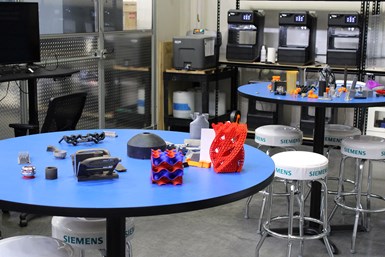Siemens Opens Charlotte Advanced Technology Collaboration Hub
Siemens says it will use this research and development space to collaborate with key OEMs, end users and U.S. national laboratories to help advance the successful industrialization of additive manufacturing.

Siemens’ Charlotte Advanced Technology Collaboration Hub (CATCH) in Charlotte, North Carolina, is designed to help Siemens customers accelerate their plans for the industrialization of additive manufacturing. Photo Credit: Siemens
Siemens has opened its Charlotte Advanced Technology Collaboration Hub (CATCH) in Charlotte, North Carolina. This strategic research and development hub is spearheaded by Siemens Digital Industries, Siemens Technology and Siemens Energy (which now operates as a separate company) to focus on helping customers accelerate their plans for the industrialization of additive manufacturing (AM).
Specifically, Siemens will use this space to collaborate with key machine builders (OEMs), end-users and U.S. national laboratories to ensure the successful industrialization of AM. Siemens says it is also partnering with ExOne, Xerox and Roboze to ensure that Siemens and its collaborators have the most advanced hardware on the market.
“We are excited to launch this new additive manufacturing hub and to begin inviting customers in to collaborate and find ways to accelerate the industrialization of this technology,” says Tim Bell, additive manufacturing business manager, Siemens Digital Industries. “The benefits of additive manufacturing are clear — from faster time-to-market to better design through digital prototypes, to localized manufacturing helping to reduce supply chain constraints. We believe that future of manufacturing is additive.”
Over the years, Siemens says it has been focused on bringing emerging technologies to the point of industry acceptance and standardization. From computerized numerical controls (CNC) to industrial software, Siemens says it seeks to enable trailblazers to advance the world we live in.
“The CATCH center will not only help industrialize additive manufacturing but also help incubate and grow the next generation of cutting-edge technology to solve industry’s hardest manufacturing problems,” says Dr. Hallee Deutchman, head of research in materials and industrialized manufacturing (U.S.) for Siemens Technology.
Siemens says it plans to accomplish this by empowering its network of partners and customers to create, make and use additive applications at scale.
It is said CATCH will be the entry point for manufacturers to understand how and why AM is crucial to designing products more effectively, manufacturing them closer to the point of purchase and creating a more resilient supply chain. The companys says CATCH will become one of seven hubs strategically placed at major AM ecosystems around the world with the distinct focus of facilitating customer AM journeys.
Related Content
-
Video: 5" Diameter Navy Artillery Rounds Made Through Robot Directed Energy Deposition (DED) Instead of Forging
Big Metal Additive conceives additive manufacturing production factory making hundreds of Navy projectile housings per day.
-
Two 12-Laser AM Machines at Collins Aerospace: Here Is How They Are Being Used
With this additive manufacturing capacity, one room of the Collins Iowa facility performs the work previously requiring a supply chain. Production yield will nearly double, and lead times will be more than 80% shorter.
-
How Machining Makes AM Successful for Innovative 3D Manufacturing
Connections between metal 3D printing and CNC machining serve the Indiana manufacturer in many ways. One connection is customer conversations that resemble a machining job shop. Here is a look at a small company that has advanced quickly to become a thriving additive manufacturing part producer.













